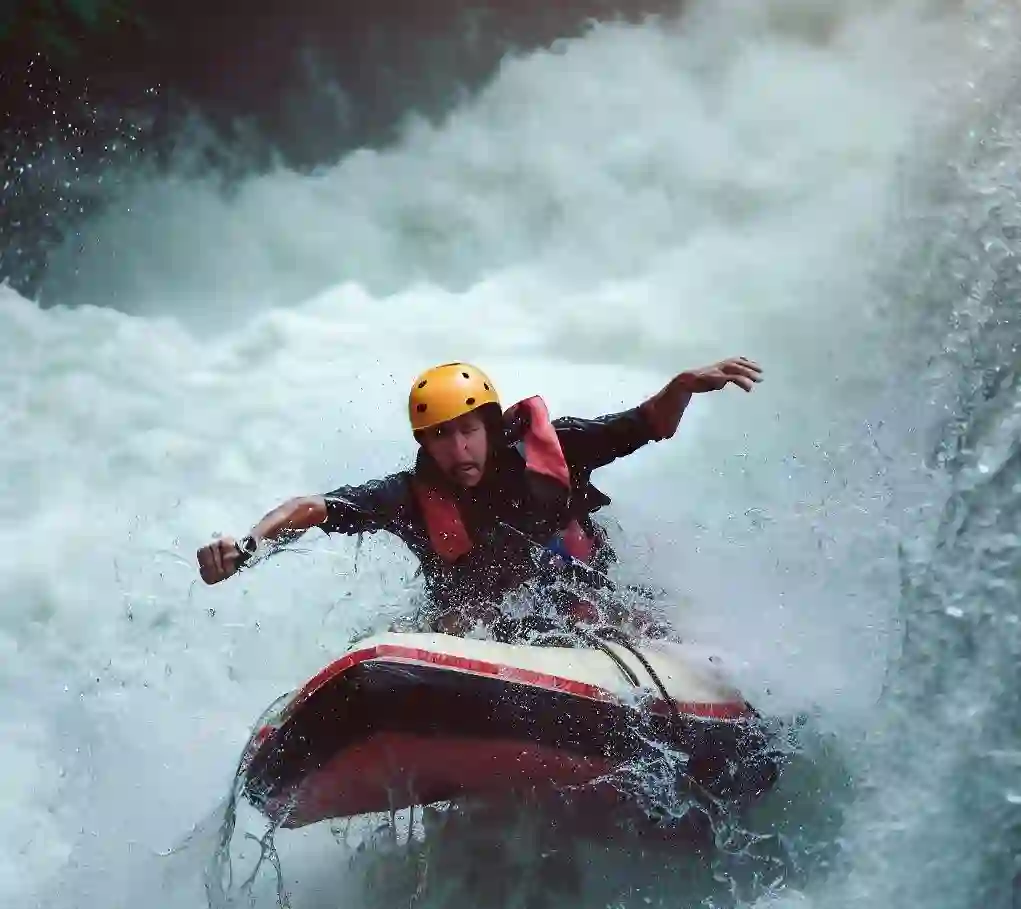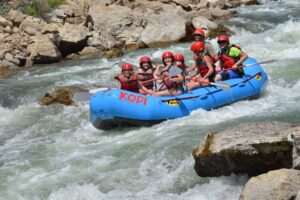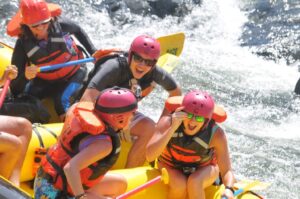White water rafting can be dangerous, but with proper safety measures and experienced guides, the risk can be minimized. White water rafting is an adventurous water sport that involves navigating through rough and swift-moving rivers on inflatable rafts.
It can be an exhilarating experience that is not for the faint of heart, but also poses certain risks. The powerful currents and rocky terrain can be dangerous for inexperienced individuals who do not follow proper safety guidelines. However, with the right precautions in place, white water rafting can be a thrilling and safe activity for all skill levels.
In this article, we will explore the dangers of white water rafting and how to mitigate them, as well as the benefits and excitement that come with this thrilling sport.

What Is White Water Rafting And Why It Is Thrilling
White water rafting is a thrilling sport enjoyed by adventure enthusiasts worldwide. But what is it exactly that makes this activity so exciting? Let’s explore the definition of white water rafting, its history, different types, and what makes it so exhilarating.
Definition Of White Water Rafting
White water rafting is an outdoor recreational activity that involves navigating through river rapids in an inflatable raft. It requires a team of paddlers working together to maneuver the raft through different levels of white water. It’s a high-energy adventure sport that’s both physically and mentally challenging.
History Of White Water Rafting
White water rafting has been around for centuries. Originally, it was a means of transportation for early settlers and explorers navigating through rivers in search of new territories. It wasn’t until the 1970s that white water rafting became a recreational sport.
Today, it’s a popular activity enjoyed around the world, with different variations and levels of difficulty.
Types Of White Water Rafting
There are varying degrees of difficulty when it comes to white water rafting. Here are the different types of white water you might encounter as a rafter:
- Class i: Easy rapids, more like a gentle float down the river.
- Class ii: Small rapids with some potential obstacles to maneuver around.
- Class iii: Intermediate rapids with higher waves and rougher water.
- Class iv: Advanced rapids with powerful waves and drops, requiring more technical skills.
- Class v: Expert-level rapids with steep drops, huge waves, and dangerous rock formations. These require precise navigation and skills.
What Makes White Water Rafting So Thrilling
The adrenaline rush and sense of accomplishment from navigating through rapids is what makes white water rafting so thrilling. However, there’s more to it than just that. White water rafting offers the following unique experiences:
- The thrill of the unknown. Each river is different, and the conditions are constantly changing. This unpredictability adds to the excitement and challenge of the sport.
- The need for teamwork. White water rafting requires a team effort to navigate through the rapids successfully. This bonding experience creates a strong sense of camaraderie among participants.
- The opportunity to connect with nature. White water rafting offers a chance to experience nature’s beauty up close. The rush of the water, the awe-inspiring scenery, and fascinating wildlife are all part of the experience.
White water rafting is a thrilling outdoor activity that offers a unique experience to participants. Its history, different types, and what makes it so exhilarating are all reasons why adventure seekers continue to enjoy this sport today. Are you ready to jump into a raft and brave the rapids?
The Potential Dangers Of White Water Rafting

White water rafting is a thrilling adventure sport that people often love to indulge in. However, it’s also crucial to keep in mind that this exhilarating experience comes with its own set of challenges. This section will cover the various hazards related to white water rafting, ranging from physical injuries and safety gear prerequisites to risks of drowning and variable water and weather circumstances.
Injuries That Can Occur During White Water Rafting
White water rafting involves paddling through fast-flowing water, making it necessary to be physically fit. However, even the fittest of individuals can sustain injuries if they’re not cautious enough. Here are some of the common injuries that one could get:
- Cuts and bruises
- Broken bones
- Sprains and strains
- Head and spinal injuries
Safety Equipment Needed For White Water Rafting
White water rafting requires specific safety equipment for the paddlers to ensure their safety. While the type of equipment may vary depending on the level of difficulty and the location of the rafting spot, here are some basic safety gears that you should pack:
- Personal flotation devices (pfds)
- Protective helmet
- Wetsuits, or drysuits and spray jackets
- Appropriate footwear
- Throw ropes
- Whistles
- First-aid kit
Risks Of Drowning And How To Prevent It
Drowning is one of the most severe risks one could face during white water rafting. Here are some reasons:
- Raft overturning
- Weak swimmers or non-swimmers
- Getting trapped under the water
However, there are a few ways to guarantee water safety:
- Wear a pfd
- Always keep your helmet securely fastened
- Hold onto the raft handles and legs tightly
- Never stand up in moving water
- Keep an eye out for signs of distress from other paddlers
The Role Of Weather And Water Conditions In Rafting Safety
Weather and water conditions play a vital role in deciding if it’s safe to go rafting. Water levels, temperature, and weather forecast are critical factors to consider when planning a rafting trip. Here are some precautions to take:
- Always listen to the weather forecast before going out rafting
- Avoid rafting in violent weather conditions
- Be extra cautious when water levels are high
- Always follow the instructions of your raft guide
If you’re well-prepared and follow proper safety measures, white water rafting can be a thrilling and unforgettable experience. Be well-informed, pack the necessary safety equipment, and choose authorized operators that will guarantee your safety.
How To Minimize Risk When White Water Rafting
White water rafting is an exhilarating outdoor activity that involves navigating through rapids in a raft. While white water rafting can be an adrenaline-pumping experience, many people worry about the risks involved. In this blog post, we’ll explore how to minimize risks when white water rafting, to ensure that you have a safe and enjoyable time.
Finding An Experienced Guide And Company
When it comes to finding a guide and company for white water rafting, experience and expertise matter. Here are some key points to keep in mind:
- Look for a company that has been in business for several years and has a good safety record, with positive reviews and ratings from customers.
- Choosing a guide with adequate experience and proper certifications can add an extra layer of protection to your rafting trip.
- Take the time to read reviews and research the company’s safety policies and procedures before making a decision.
Proper Training Before Going On A White Water Rafting Trip
To minimize the risks involved in white water rafting, proper training is essential. You should ideally go through some level of training or instruction before heading out onto the river. Here are some points to bear in mind:
- Look for rafting companies that offer training programs for beginners, as well as refresher courses for more experienced rafters.
- Make sure you practice paddling and maneuvering in calm waters before attempting rapids.
- Learning about the different types of rapids and how to navigate them can increase your chances of a safe and successful trip.
Ensuring Safety Equipment Is Properly Fitted And Maintained
Safety equipment is essential when it comes to white water rafting. The equipment must be carefully fitted and maintained to ensure maximum protection. Here are some key points to keep in mind:
- Look for companies that provide high-quality safety equipment, including life jackets, helmets, and wetsuits.
- Make sure your safety equipment fits you properly, particularly your life jacket.
- Check your equipment before heading out onto the river. Any damaged or malfunctioning gear should be immediately replaced.
Making Informed Decisions About Which Rapids To Navigate
While white water rafting can be an exciting adventure, it’s essential to make informed decisions about which rapids to navigate. Here are some important points to consider:
- Always consult with your guide and follow their instructions.
- Before choosing a set of rapids, ask about their classification and level of difficulty.
- Be realistic about your abilities and the abilities of the other members of your group.
By following these guidelines, you can minimize risks when white water rafting and ensure that you have an enjoyable and safe experience. Remember, choosing a reputable guide and company, getting proper training, ensuring safety equipment is correctly fitted and maintained, and making informed decisions about which rapids to navigate are all key to staying safe on the river.
Frequently Asked Questions Of Is White Water Rafting Dangerous
Is White Water Rafting Dangerous For Beginners?
White water rafting can be safe for beginners with proper training, safety equipment, and experienced guides.
What Are The Risks Of White Water Rafting?
The risks of white water rafting include drowning, injury from collisions or falls, and cold water shock.
What Safety Measures Should Be Taken For White Water Rafting?
Safety measures for white water rafting include wearing proper safety gear, choosing an appropriate level of difficulty, and following the instructions of experienced guides.
Conclusion
After weighing all the pros and cons of white water rafting, it’s safe to say that white water rafting can be dangerous in certain circumstances. However, with proper training and safety measures, many of the risks associated with this thrilling sport can be mitigated.
Like any adventure sport, there are always going to be risks, but these risks can be managed and minimized with the right approach. It’s essential to choose a reputable and experienced outfitter, wear appropriate safety gear, and follow the guide’s instructions diligently.
White water rafting can be a fun, exciting, and safe activity for individuals and groups of all ages. It’s all about proper planning, preparation, and execution to ensure that everyone has an unforgettable experience while staying safe. So, if you’re considering white water rafting, go ahead and do it – but do it right!


